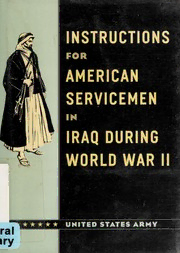
Instructions for American servicemen in Iraq during World War II PDF
Preview Instructions for American servicemen in Iraq during World War II
INSTRUCTIONS FOR AMERICAN SERVICEMEN IN IRAQ DURING WORLD WAR II ***** UNITED STATES ARHY INSTRUCTIONS FOR AMERICAN SERVICEMEN IN IRAQ DURING WORLD WAR II With a New Foreword by Lieutenant Colonel John A. Nagl "American success or failure in Iraq may well depend on . ^ '■ • • whether the Iraqis like American soldiers or not.” T hat bit of advice is from a pocket manual which was in the kit bags of thousands of Ameri¬ can soldiers in 1943 as they were deployed to Iraq to help the Brit¬ ish guard against Nazi infiltration. Presented here in a new facsimile edition. Instructions for American Servicemen in Iraq during World War II was designed to help the soldiers understand and cope with what was at the time an utterly unfamiliar culture—the manual ex¬ plains how to pronounce the vtard C ’ ^ fjplib (continued on back flap) INSTRUCTIONS FOR AMERICAN SERVICEMEN IN IRAQ DURING WORLD WAR II PAGES I-44 OF THIS BOOK ARE A FACSIMILE OF A “POCKET GUIDE” PREPARED BY THE SPECIAL SERVICE DIVISION OF THE ARMY SERVICE FORCES, UNITED STATES ARMY IN I943. ALL SPELLINGS AND PUNCTUATION ARE REPRODUCED AS THEY APPEAR IN THE ORIGINAL 1943 PUBLICATION. INSTRUCTIONS FOR AMERICAN SERVICEMEN IN IRAQ DURING WORLD WAR II WITH A NEW FOREWORD BY LIEUTENANT COLONEL JOHN A. NAGL TIIF. UNIVERSITY OF CHICAGO PRESS ★CHICAGO AND LONDON Pages 1-44 of this book are a facsimile Library of Congress of a “pocket guide” prepared by the Cataloging-in-Publication Data Special Service Division of the Army United States. Army Service Forces. Service Forces, United States Army Special Service Division. in 1943. Instructions for American servicemen This work is reproduced with the kind in Iraq during World War II / [Special assistance of the Special Collections Service Division of the Army Service Research Center at Regenstein Library, Forces] ; with a new foreword by LT C the University of Chicago. John A. Nagl. p. cm. The University of Chicago Press, “Pages 1—44 of this book are a facsimile Chicago 60637 of a ‘pocket guide’ prepared by the The University of Chicago Press, Ltd., Special Service Division of the Army London Service Forces, United States Army Foreword by John A. Nagl in 1943.” © 2007 by The University of Chicago ISBN-13: 978-0-226-84170-0 All rights reserved. Published 2007 (cloth : alk. paper) isbn-io: 0-226-84170-7 No copyright is claimed for the text (cloth : alk. paper) of the “Short Guide to Iraq” (pages 1. Iraq. 2. National characteristics, 1-44) published by the War and Navy Iraqi. I. Nagl, John A., 1966- II. Title. Departments of the United States DS79.U6 2007 Army in 1943. 956.7—dc22 Printed in the United States of America 2007006100 12 11 xo 09 08 07 23456 ® The paper used in this publication meets the minimum requirements of ISBN-13: 978-0-226-84170-0 (cloth) the American National Standard for isbn-io: 0-226-84170-7 (cloth) Information Sciences—Permanence of Paper for Printed Library Materials, ansi Z39.48-1992. A SHORT GUIDE TO “A SHORT GUIDE TO IRAQ” (1943) History doesn’t repeat itself, but it often rhymes. This wonder¬ ful guide was prepared to inform American troops assigned to Iraq in 1943 how best to assist the British guarding it against Nazi infiltration.1 It would be just as useful to those assigned there today; indeed, I wish that I had read it before beginning my own yearlong tour in A1 Anbar in late 2003! Some of the guidance in this little book is eerie to anyone who has fought in Iraq recently: “That tall man in the flowing robe you are going to see soon, with the whiskers and the long hair, is a first-class fighting man, highly skilled in guerrilla warfare. Few fighters in any country, in fact, excel him in that kind of situation. If he is your friend, he can be a staunch and 1. Iraq has always been a complicated place. In May of 1941 the British were forced to reimpose a friendly government after a pro-Nazi insurgency had temporarily deposed their man in Iraq the previous month. v valuable ally. If he should happen to be your enemy—watch out!” Would that we had listened to the warning that the Ar¬ abs are skilled guerilla fighters, a warning trumpeted exactly sixty years later by retired Marine Colonel Gary Anderson in April of 2003, even before Baghdad had fallen. Would also that we had listened to lessons already learned but long forgotten, advice such as “The nomads are divided into tribes headed by sheikhs. These leaders are very pow¬ erful and should be shown great consideration.” A policy that showed greater consideration to the Sunni sheiks and to their interests in the immediate aftermath of the toppling of Saddam Husseins regime in 2003 might have prevented the fervent insurgency from being raised to the fever pitch it has taken recently—for, as the 1943 guide warns in stunning understatement, “The Iraqis have some religious and tribal differences among themselves.” It is almost impossible, when reading this guide, not to slap oneself on the forehead in despair that the Army knew so much of Arabic culture and customs, and of the importance of that knowledge for achieving military success in Iraq, six decades ago—and forgot almost all of those lessons in the intervening years. It is a sad fact of history that armies all but invariably forget the lessons of prior campaigns and have to relearn them from scratch when war begins again, at the cost of too many soldiers’ and civilian lives. One hopes that ■A- -* VI
